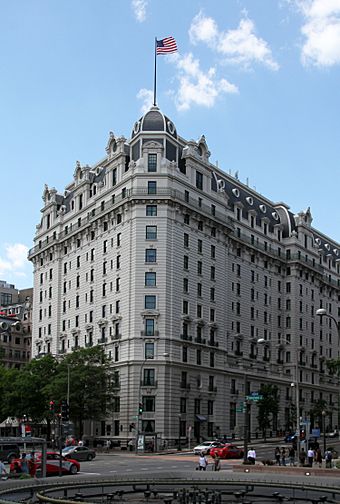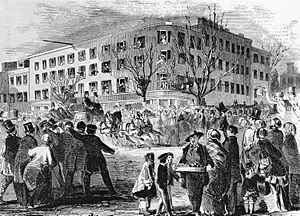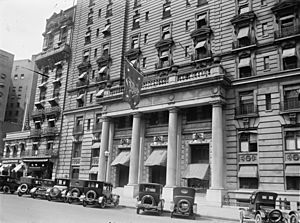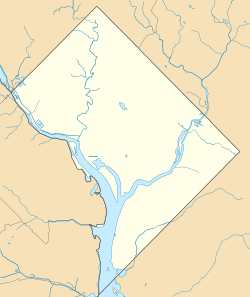Willard InterContinental Washington facts for kids
Quick facts for kids |
|
|
Willard Hotel
|
|

Willard Hotel in 2016
|
|
| Location | 1401–1409 Pennsylvania Avenue NW, Washington, D.C., U.S. |
|---|---|
| Built | Original six structures: 1816 Unified structure: 1847 Current structure: 1901 |
| Architect | Henry Janeway Hardenbergh (hotel) Hardy Holzman Pfeiffer Associates and Vlastimil Koubek, annex |
| Architectural style | Beaux-Arts |
| NRHP reference No. | 74002177 |
| Added to NRHP | February 15, 1974 |
The Willard InterContinental Washington, often called the Willard Hotel, is a famous luxury hotel in Downtown Washington, D.C.. It is known for its beautiful Beaux-Arts architecture style. The hotel has many fancy guest rooms, restaurants, the well-known Round Robin Bar, and shops. It also has large rooms for events. The Willard Hotel is very close to the White House and the Metro Center train station.
Contents
History of the Willard Hotel
The first buildings on this spot were six small houses. Colonel John Tayloe III built them in 1816. Joshua Tennison rented these houses and turned them into Tennison's Hotel. For about 30 years, the buildings were used as a hotel. Their name and who ran them changed a few times. By 1847, the buildings were old and needed repairs.
How the Willard Hotel Started
The hotel we know today was started by Henry Willard in 1847. He rented the six old buildings. Henry Willard then joined them together into one large, four-story hotel. He called it Willard's Hotel. In 1864, Willard bought the hotel property. There was a disagreement about how much he should pay. This led to a big legal case that went all the way to the Supreme Court of the United States. The Supreme Court decided that Willard had to pay the agreed price in gold coins.

The current 12-story building opened in 1901. It was designed by a famous hotel architect, Henry Janeway Hardenbergh. In 1922, a large fire caused a lot of damage. Many important people had to leave the hotel. This included Vice President Calvin Coolidge and other leaders. For many years, the Willard was the only hotel where you could easily visit all of downtown Washington. Because of this, many important people have stayed there.
Changes and Reopening
The Willard family sold their part of the hotel in 1946. The hotel closed suddenly on July 16, 1968, because of problems and the area changing. The building was empty for many years. There were even talks about tearing it down. Eventually, it was sold to a group that worked on developing Pennsylvania Avenue. They held a contest to fix up the hotel. The Oliver Carr Company and Golding Associates won. They then brought in IHG Hotels & Resorts to help own and run the hotel. The Willard was made beautiful again, looking like it did at the start of the 1900s. An office building was also added next to it. The hotel reopened with a big celebration on August 20, 1986. Many Supreme Court justices and senators attended. The hotel was updated again in the late 1990s.
Meetings at the Willard Hotel
News reports in 2021 said that some rooms at the hotel were used for meetings. These meetings happened before the 2021 United States Capitol attack on January 6. People involved in these meetings discussed ways to challenge the results of the 2020 election. A lawyer named John C. Eastman talked about his ideas for the Vice President to delay certifying election results. The United States House Select Committee on the January 6 Attack later looked into these meetings. They asked some people who were there to provide information. Reports also said that Donald Trump called people at the hotel on January 5. He wanted to discuss how to delay the election results. The House committee also planned to investigate this phone call. An aide to Trump's Chief of Staff, Cassidy Hutchinson, later said that Trump asked his Chief of Staff to call people in the Willard "war room." This suggested a direct link between the White House and some groups involved in the Capitol attack.
Famous People Who Stayed at the Willard

In 1860, the first group of Japanese ambassadors to the United States stayed at the Willard. There were 74 other delegates with them. They noticed their hotel room was even nicer than the U.S. Secretary of State's house. This was the first time an official Japanese group traveled to another country. Many people came to see the Japanese delegates carrying their swords.
In the 1860s, writer Nathaniel Hawthorne said the Willard Hotel was more like the "center of Washington" than the Capitol or the White House.
Important Historical Events
From February 4 to February 27, 1861, a "Peace Congress" met at the Willard. Delegates from 21 states tried to stop the American Civil War. A plaque outside the hotel remembers this effort. Later that year, Julia Ward Howe wrote the words to "The Battle Hymn of the Republic" while staying at the hotel. She heard a Union army group singing "John Brown's Body" outside her window.
Many U.S. presidents have visited the Willard. Every president since Franklin Pierce has either slept there or attended an event. This is why the hotel is sometimes called "the residence of presidents." Ulysses S. Grant used to relax in the lobby, smoking a cigar. Some people say this is where the word "lobbying" came from. However, this is probably not true, as the word was used earlier.
Grover Cleveland lived at the hotel at the start of his second term in 1893. He did this because of concerns about his baby daughter's health. There had been a sickness at the White House. Plans for Woodrow Wilson's League of Nations were discussed at meetings in the hotel lobby in 1916. Six Vice Presidents have lived at the Willard. Millard Fillmore and Calvin Coolidge even stayed there after becoming president. This gave their families time to move into the White House.
In April 1922, a fire broke out while Calvin Coolidge was staying there as Vice President. When he tried to go back inside, a fire marshal asked him to identify himself. Coolidge said, "I'm the Vice President." The fire marshal replied, "What are you vice president of?"
On October 2, 1922, many officers from World War I met at the Willard Hotel. They formally started the Reserve Officers Association (ROA). The first meeting of the American Association for Cancer Research also happened at the Willard on May 7, 1907.
During World War II, the British government rented several floors of the Willard. They used it for their supply organization. A special plaque near the hotel entrance remembers this.
Martin Luther King Jr. wrote his famous "I Have a Dream" speech in his hotel room at the Willard. This was in 1963, just before the March on Washington for Jobs and Freedom.
In 2001, director Steven Spielberg filmed the end of his movie Minority Report at the hotel. He filmed with Tom Cruise and Max von Sydow in the Willard Room, Peacock Alley, and the kitchen.
More recently, in 2012, Australian Foreign Minister Kevin Rudd gave a speech there. In 2021, Indian Prime Minister Narendra Modi also stayed at the hotel. Even the turkeys pardoned by US President Donald Trump, named Bread and Butter, stayed at the Willard before their ceremony.
Hotel Ratings
The AAA gave the Willard Hotel four diamonds out of five in 1986. The hotel has kept this rating every year since then. Forbes Travel Guide also listed it as a "recommended" property in 2016.
Gallery
-
The Washington Monument as seen from the Willard Hotel
-
Mary Martin and Carol Channing in the lobby, 1986. They were performing in the play Legends!
See also
 In Spanish: Hotel Willard para niños
In Spanish: Hotel Willard para niños









